Engagement. That word means a lot of different things to a different people, but there’s no denying the fact that we all want it.
Whether it’s comments, shares, Likes, Retweets… engagement shows you just how much people care about your brand.
Part of my role at Econsultancy is getting people to engage more with our content on our social channels, so I thought I’d list a few methods that should see your engagement rocket.
Come on, let’s go and blow the doors off…
Before we begin, here I’m defining ‘engagement’ as ‘any action’. So this might include a click on a link or image, a retweet, a favourite or a reply.
Let’s start with a basic tweet.
Thanks to Twitter’s ongoing updates, there are a number of ways to get more bang for your buck here.
If you have time and tech access, then you could automate the use of Twitter cards. We’ve experimented with these in the past, and while the response numbers were low, I did find that the cards were very accurately targeted, gaining responses from some excellent users.
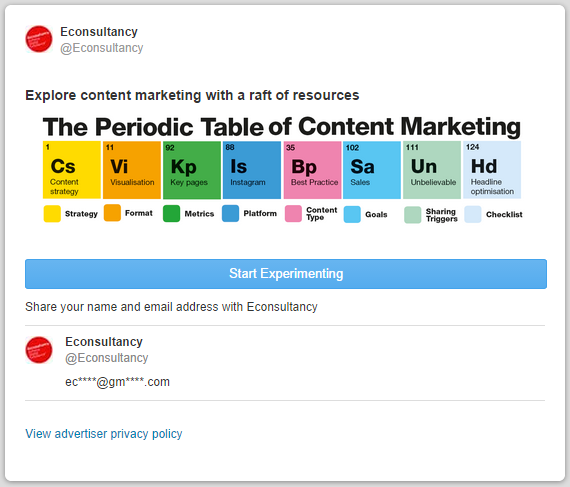
In many ways this is similar to Adwords PPC, something Econsultancy has traditionally struggled to scale given our somewhat niche market (Short version: ‘Multichannel attribution strategy’ isn’t likely to challenge ‘pizza’ in the search volume stakes any time soon), but if you have a very specific target market in mind these can work very well.
But never mind that, here’s the low down and dirty regular tweets version.
Over the past few weeks I’ve sent a LOT of tweets. Some were text, some had pictures, some had hashtags, some didn’t. What worked best?
Images
Images people liked and engaged the most with:
Colourful charts, infographics and cartoons.
People like big, colourful pictures. They like them more if they look like they include information, and there are twin psychological reasons for this.
- Firstly, it’s a (I’m sorry for using this phrase, I really am) value-add. You don’t even have to click on a link to get at that sweet sweet insight.
- Secondly, it’s easy to share this and show people that you too are a valuable source of information (Or if you’re like me, at least give the appearance of knowing what you’re talking about).
Clicks on the images, favourites and shares were all popular actions with these, as Chris Lake’s eternally popular Periodic Table of Content Marketing shows, investing in useful infographics is full of win.
Lots of requests coming in today for the Periodic Table of #ContentMarketing: https://t.co/6FebiyTWJJ pic.twitter.com/w2jo4oe7LZ
— Econsultancy (@Econsultancy) July 29, 2014
There are niche wins to be had here as well.
The two follow-up charts detailing content marketing team structure and metrics weren’t quite as successful. Instead, they were slow burners, but tended to be picked up by people who, at least on the face of it, are more likely to spend some actual money with us.
Introducing the #ContentMarketing Team Matrix http://t.co/tmEZs0tdAG pic.twitter.com/JAlQFpV3Iz
— Econsultancy (@Econsultancy) August 27, 2014
A Smörgåsbord of #contentmarketing Metrics http://t.co/tkVglgYoZg pic.twitter.com/335PWH6xzL
— Econsultancy (@Econsultancy) September 16, 2014
Unless you are a broadcaster or FMCG, targeting matters more than reach.
Just to underline this point, here’s a shot of our Twitter analytics. Look at the difference between the regular tweets and the one with an image attached.
And that’s the back of a truck, hardly the most engaging thing on Earth:
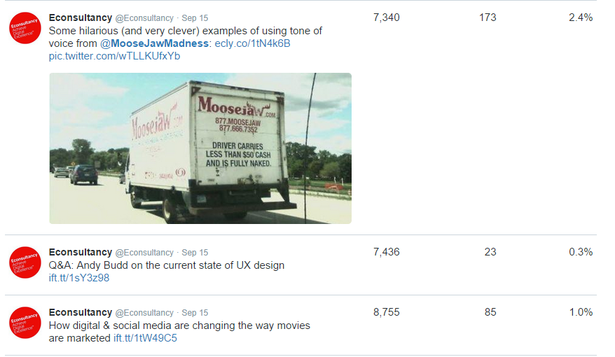
This may seem fairly obvious to anyone who’s ever tweeted from a conference –people love soundbites and stats, and if you can back them up with some interesting graphic you’re on to a winner.
(Remember, the 3.3% engagement rate is based on people who saw your tweet, not your total followers)
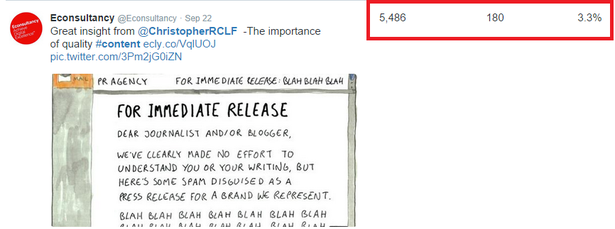
Cartoons an also work well (The Marketoonist gets shared like nobody’s business), but they need to be fresh and funny. Otherwise you risk falling into the dreaded…
Stock photography
People hate stock imagery.
Air-pumping businessmen. Confused marketers. Women laughing while eating salads, logos. All these say that you are too lazy to come up with something original.
#ContentMarketing for YouTube made easy https://t.co/umTO7Vq7dJ pic.twitter.com/FEZFGQJUQI
— Econsultancy (@Econsultancy) September 10, 2014
If you can’t be bothered with an original image, then the assumption is that your content will be the same. Boring and repeated ad nauseum.
Anything that looks like it’s selling something
This is a subtle one. We often write site reviews and I’m inclined to include a screenshot on Twitter, but when that screenshot included an image of a site with a huge ‘SALE!’ banner, engagement dropped down dramatically.
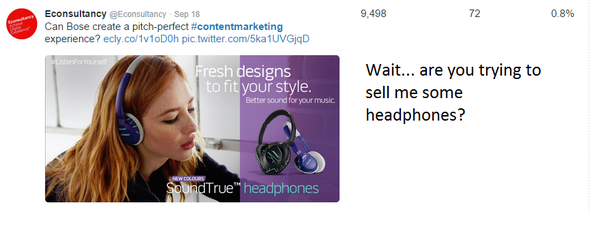
Even subconsciously, we don’t want to be seen to be shilling things on Twitter.
Stills from pop culture
Well, what else would you use to illustrate a post about predicting the future of marketing?
Anything, as long as it isn’t a still from Back To The Future (or any other film ever).
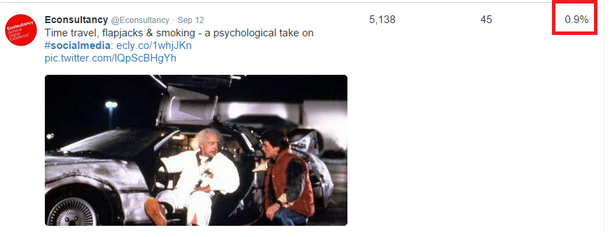
Brilliant film, terrible engagement.
Faces
Simple question: What is the worst thing in the world?
If you answered ‘everyone else’ then you’re on the right track.
People just don’t like pictures of people’s faces. Some celebrities break this trend, but only if tweeting from their own account. If you see a picture of Richard Simmons pop up on a brand account, chances are he’s selling something.
I thought about the reasons behind this long and hard, and while I’m happy to be corrected by a psychologist, it seems to me that it just comes across as a little too try-hard. It’s a forced level of engagement that users try to avoid, so you should too.
Incentivizing your retailers to drive brand advocacy http://t.co/pUNu495iM3 pic.twitter.com/gTrxU4oQkW
— Econsultancy (@Econsultancy) September 8, 2014
To my everlasting shame, this tweet commits a number of heinous sins.
It has a stock image of somebody’s face, includes a buzzword AND looks like it’s selling something.
I should be beaten with a hose for this, but instead I’ll just take its paltry 0.8% engagement rate on the chin and learn from it.
Animated Gifs
Gifs on the other hand rule. Probably because they are usually either amusing, or they exist somewhere so deep in the Uncanny Valley that they become fascinating in their own right.
Four inventive ways to distribute your #content http://t.co/42C3ad7le3 http://t.co/1JuMPC1LZO
— Econsultancy (@Econsultancy) September 24, 2014
They also have the advantage of standing out from the crowd in the Tweetstream, but unfortunately they don’t show up properly in Tweetdeck (or apparently, when tweets are embedded) or similar apps, so use sparingly and think about your target audience before deploying.
Memes
Y u no use memes? As Ben Davis has pointed out in the past, everyone loves a good meme, so there’s no reason why u can no haz them either.
I’ve been making particularly stupid ones for The Digitals recently, and they are proving engage-o-riffic.
Thinking about not entering the most sought-after awards in digital marketing and ecommerce? http://t.co/wQuW8M9fg3 pic.twitter.com/6xyVlOZf1S
— Econsultancy (@Econsultancy) September 17, 2014
Get meme-ing.
Hashtags
Now we’ve covered images, let’s get old school. Do #hashtags still work?
Do all those social media experts telling you to use more of them really know what they are talking about? Um… yes, they do actually.
Again, you need to think about this in advance. Hashtags that are not related to specific events tend to work better with the US audience. The practice is simply more widespread among users. That’s not to say other territories don’t use them though, and they are particularly prevalent in our market sector, so do make sure you experiment yourself.
That said, they work. Tweetdeck now helpfully offers you suggested hashtags as you type in certain phrases, which I’m assuming are based on popular combos.
#Socialmedia works better than just #social, and #contentmarketing seems to be a big hit at the moment.
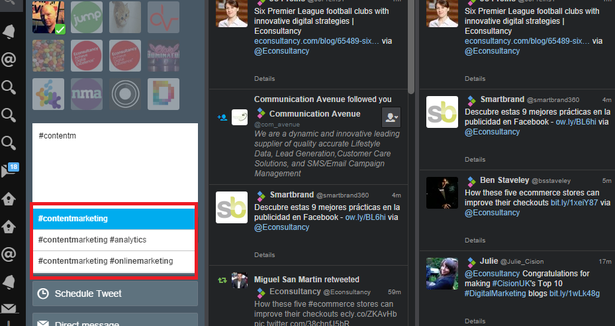
Tweets with hashtags definitely get higher engagement, but don’t use more than two in a tweet.
@Names
Popular wisdom suggests that adding in an @name will increase exposure, and it appears to have a very slight impact on engagement as well.
It’s not a world beater though (although you use @OneDirection at your peril), so may be better employed when you want someone to know about an article you’ve written or are just after some good old customer service.
The quest for the ultimate Tweet
Is there an optimum mix? Probably not. Based on our experiences it appears if you are using the right kind of images then they are a gift that keeps on giving, but be sure to mix them up so that you don’t become too dry and formulaic.
Likewise, add personal touches and communicate personality through these images as you go.
For @Econsultancy at least, the ideal tweet looks something like this:
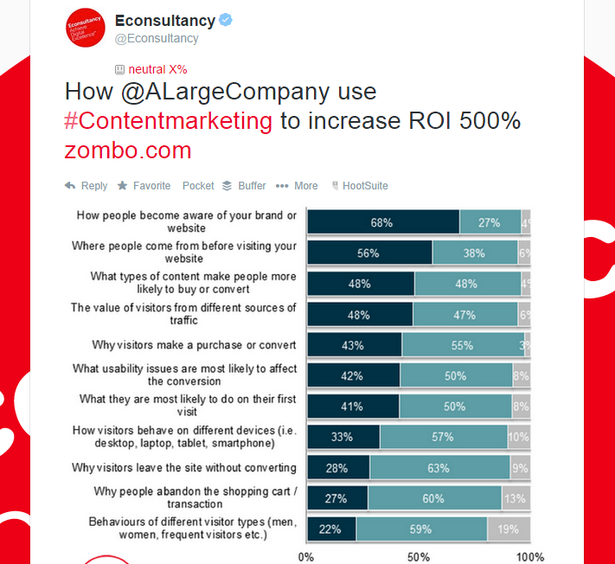
(And yes, I do urge you to check out Zombo.com as often as possible) Add these to existing optimisation rules (Keep tweets under 90 characters if possible, don’t flood your followers feeds if you can help it etc etc) and you can’t lose.*
Using these ideas has seen engagement, on average, quadruple around each of @Econsultancy’s tweets in the past few months.
*Losing still possible if your content is rubbish.


















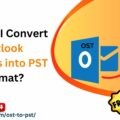


No Comments